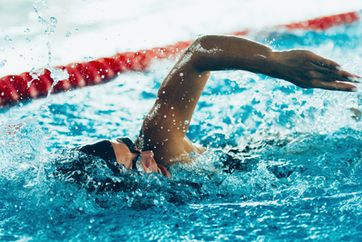Elite swimming associated with smaller BMD gains vs. nonaquatic sports
A cohort of female Olympic swimmers had lower bone mineral density measurements at all sites when compared with nonaquatic elite athletes, suggesting that weight-bearing or strength activities out of water could be incorporated into training to improve bone health, according to findings published in Bone.
“Physical exercise is highly beneficial to increase BMD and bone mineral content as a powerful protective factor to limit the emergence of osteopenia that ends in osteoporosis development,” Montse Bellver, MD, of Centro de Alto Rendimiento in Barcelona, Spain, and colleagues wrote in the study background. “However, there is not enough evidence regarding the exercise’s intensity and length required for this osteogenic stimulation to occur. The intensity of the stimulus seems more important than its length. This is the main reason that explains why not all physical activities have the same effect on bone.”
In a cross-sectional, observational study, Bellver and colleagues analyzed data from elite female athletes from the Spanish Olympic teams who participated in at least 12 to 15 hours of weekly training in swimming (n = 19), synchronized swimming (n = 24) and water polo (n = 14) with data from elite female athletes in professional soccer (n = 92) and the Spanish national volleyball (n = 26) and field hockey teams (n = 29) and from sedentary controls (n = 126). Participants underwent whole-body, proximal femur and lumbar spine BMD scans via DXA.
The researchers found that mean BMD values were highest among the nonaquatic athletes at all measured sites, regions and segments compared with aquatic athletes. Mean total BMD measurements for nonaquatic athletes, elite swimmers and controls were 1.257 g/cm², 1.109 g/cm² and 0.943 g/cm², respectively.
“Whole BMD values follow a decreasing order for volleyball, [soccer], field hockey, water polo, swimming, synchronized swimming and controls,” the researchers wrote.
The researchers also found that all elite sport participants, including swimmers, had higher BMD values vs. sedentary controls at the lumbar spine and femur.

“Swimmers and synchronized swimmers had similar values to sedentary controls in whole-body BMD and segments,” the researchers wrote, adding that both free fat mass and sport type explained BMD and bone mineral content values in all athletes.
Compared with controls, bone mineral content was higher for all high-performance athletes except for swimmers and synchronized swimmers, who had measurements comparable to controls, according to researchers.
In a comparison between aquatic and nonaquatic athletes adjusted for training time in water and training time out of water, the researchers observed differences in relation to BMD by training time out of water (P < .046).
“In the multiple comparison analysis, statistically significant differences were found between [nonaquatic] sports with respect to swimmers plus synchronized swimmers (P < .01) and swimmers plus synchronized swimmers with respect to water polo players (P <.005),” the researchers wrote. “No statistically significant differences were found between [non-aquatic athletes] and water polo players.”
The researchers noted that BMD is not negatively compromised by the practice of aquatic sports at a highly competitive level.
“Time training out of the water improves BMD,” the researchers wrote. “Our findings suggest that swimming and synchronized swimming in female athletes should be combined with weight-bearing, impact or strength activities, as [they] do not seem to be osteogenic sports.” – by Regina Schaffer
Disclosures: The authors report no relevant financial disclosures.
